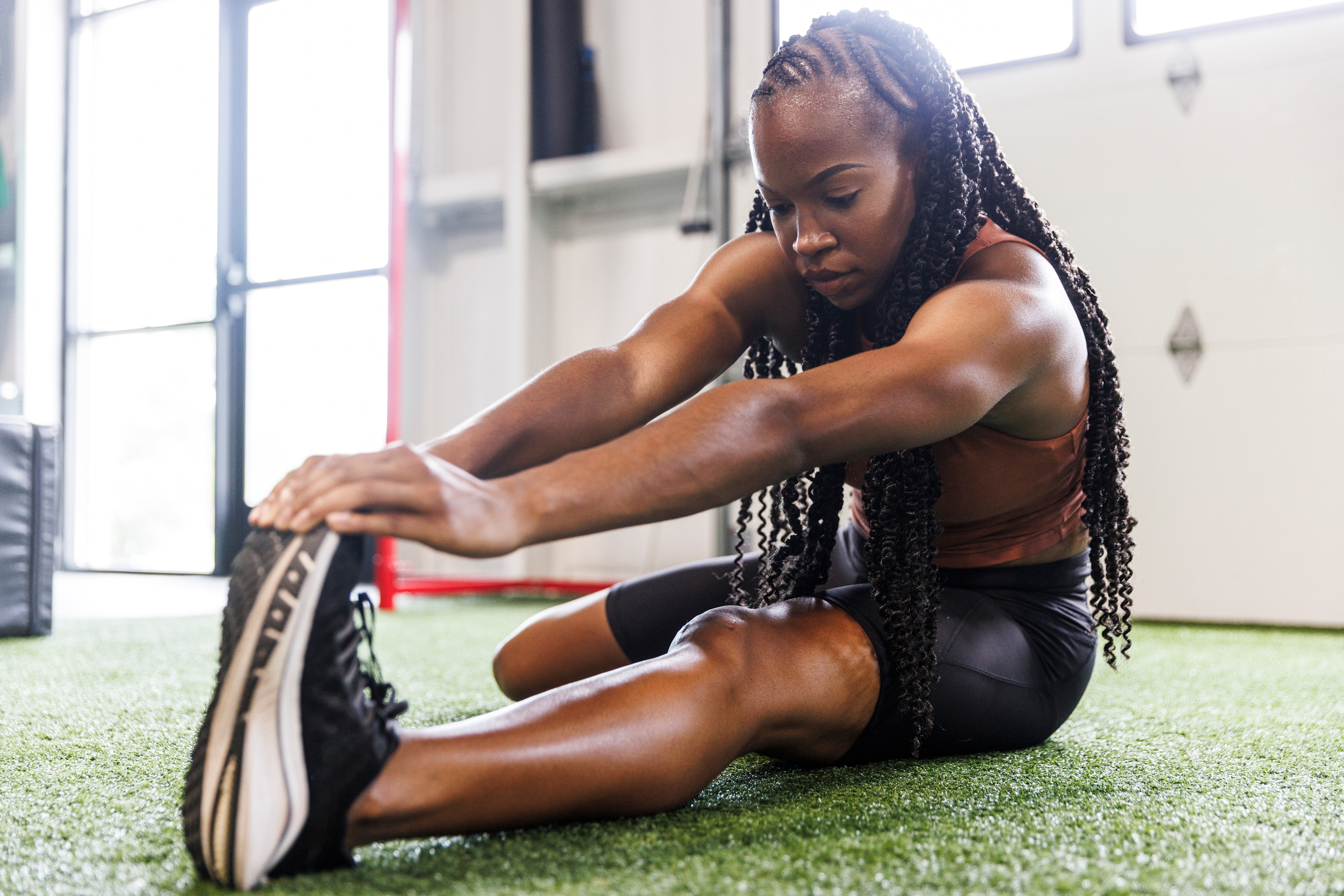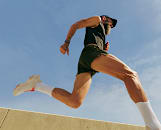
The Good Brigade via Getty Images
Can You Stretch Your Way to Bigger Muscles? Here’s What Experts Say
Some research links static stretching to muscular hypertrophy, but that doesn’t mean you can skip strength work and just stretch.
By Danielle Zickl•
Can Stretching Actually Build Muscle?
How to Stretch for Increased Muscle Mass
Why Stretching Works Best As a Supplement to Strength Training
Why Stretching Your Muscles Is Always a Good Idea
The Takeaway
If you can’t remember the last time you took a few minutes to stretch, you’re not alone. When you’re short on time, it’s understandable to want to speed past the slower, more tedious parts of a workout and prioritize the things that’ll get your heart pounding or your muscles burning. But we can’t emphasize the benefits of stretching enough: It can boost your flexibility and mobility, increase blood flow to your muscles, and may help reduce your risk of injury, just to name a few.
Discover more ways to reach your goals with Peloton
One of the other potential benefits that gets tossed around? That stretching builds muscle. A January 2024 research study published in the European Journal of Applied Physiology, for example, made headlines by suggesting that stretching can build muscle and strength as much as lifting weights.
If you’re hoping to gain muscle and get stronger, can you really pass over the dumbbells and just stretch instead? To dig deeper into the science, we tapped Peloton instructor Adrian Williams and physical therapist Grayson Wickham, founder of Movement Vault. Here’s everything you need to know.

Peloton App
Access thousands of classes with no equipment needed.
Can Stretching Actually Build Muscle?
Not really. Some research links stretching to increased muscle strength and size, but that doesn’t exactly mean that stretching alone can lead to significant hypertrophy (aka muscle growth)—and it’s certainly not the best training strategy if building muscle is your goal.
That’s because, in general, stretching doesn’t offer enough resistance or stress to stimulate muscle growth, Adrian explains. To build muscle mass, you need to challenge your muscles to the point where they incur tissue damage. Your body then repairs that damage, and your muscles adapt to become stronger so they can keep up with the demands you’re putting on them during your workouts. The most effective way to do this is through a solid resistance training program, Adrian says. While stretching may challenge your flexibility, it typically doesn’t tax your muscles enough to induce hypertrophy.
You might be thinking: What about that European Journal of Applied Physiology study? There is some literature that suggests stretching may have some sort of muscle-building effect, though it’s unclear why, how, or exactly to what extent it can actually play in increasing muscle strength and size.
Let’s get into the science. The aforementioned January 2024 study included 81 college students and found that those who participated in two months of static stretching sessions (holding a stretch in one position for a specific length of time) saw increases in muscle strength and size. However, it’s important to note the methods involved: During each session, participants held a static chest stretch for 15 minutes with a ratchet strap attached to their elbows that held them in the stretch. They did this four days per week for two months. While the study’s researchers found that this routine resulted in increased muscle mass and strength, it’s pretty unrealistic to suggest people hold a single stretch for 15 minutes straight using a strap as resistance.
Similarly, a small May 2022 study in Frontiers in Physiology found that one hour of static stretching per day for six weeks leads to hypertrophy and an increase in maximal strength—but, again, the method they used isn’t something you’ll be jumping to add to your routine. The daily stretching sessions focused on the calf muscle and were achieved by having participants sit wearing a special boot that held their foot and ankle in a stretched position for the full 60 minutes.
“The increased hypertrophy was likely due to increased muscle tension during long-duration static stretching,” Wickham says. “This is essentially the person fighting the passive stretching using an active contraction, which essentially turns this into an active stretch.”
In a 2024 research review published in Sports Medicine - Open, researchers concluded that this type of long-duration static stretching could potentially be used to help build or maintain muscle mass in people who can’t engage in other types of strength work (think: those with illness or injury), but that resistance training remains more effective and efficient for building strength and muscle.
So if your main goal is to increase strength and muscle mass, this all means that you should focus your efforts on strength training, not stretching, Adrian says.
Related Articles

Strength Train
Are You Training All of Your Muscle Groups? Here’s How to Do it—And Why it Matters

Strength Train
This Is How Long It Takes to Lose Muscle Gains During a Fitness Break

Nutrition
10 of the Best Foods for Muscle Recovery, According to Dietitians

Strength Train
Why Isolation Exercises Should Play a Supporting Role In Your Strength Routine
How to Stretch for Increased Muscle Mass
Static stretching likely won’t do much for your strength goals; however, it’s possible that dynamic stretching (active movements that take your joints through their full range of motion) could potentially be better for building and maintaining some muscle mass, Wickham says. This is mainly due to the fact that you’re actively contracting (or tensing) your muscles when doing dynamic stretches, Wickham explains. Engaging your muscles in this way puts some strain on them, which initiates the process that leads to muscle growth.
Wickham suggests performing active stretches—leg swings, alternating lunges, or inchworms, for example—for 10 minutes at a time, three days a week. From there, you can increase your duration and frequency to 15 minutes per day, five to seven days per week.
Why Stretching Works Best As a Supplement to Strength Training
Strength training—not stretching—is the gold standard for building muscle. “At the simplest level, the process of building muscle occurs when you create micro damage to your muscles during a workout and then allow adequate recovery time to then repair that muscle tissue,” Wickham explains. “The repairing of the muscle after your workouts is when you truly build muscle.”
Resistance training, specifically, causes the amount of stress needed to create this muscle damage. Some key factors that are necessary to stimulate muscle growth to this level—which you can’t achieve with stretching—include the following, according to Adrian:
Progressive overload is the concept of gradually increasing the difficulty of an exercise (by upping load, reps, time, etc.) so you continue to challenge your body. As your body adapts to your current strength training program, you’ll notice that eventually, your workouts aren’t difficult anymore. Your muscles grow in strength and size when challenged, which is why progressive overload is so important. Following a strength training program, like those offered in the Peloton App or Peloton Strength+, can help you ensure you're progressing your workouts enough to keep seeing results.
Isolation exercises are movements that target a specific muscle group, like biceps curls or triceps extensions. If your goal is to build size and strength in a specific muscle group, like your biceps, for instance, you’re better off targeting them via isolated exercises versus moves that work them plus other muscles.
Compound exercises are movements that work multiple muscle groups and joints at once, like deadlifts or dumbbell thrusters. Because compound exercises involve multiple muscle groups working together, you can typically lift heavier than you could with isolation exercises—and lifting heavier weights is one of the best ways to build muscle.
An effective strength training program using the above elements typically consists of doing eight to 20 sets per major body part, with eight to 15 reps per set, two to three days per week. “As far as intensity goes for each set, you typically want to perform each set one to two reps from failure,” Wickham says.
If building muscle and strength is your goal, stretching works best in conjunction with strength training, not in place of it. Wickham recommends performing dynamic (or active) stretches as part of your workout warm-up that involve the muscles you plan to work during your exercise session. “Active stretching is better as a supplement to strength training if the primary goal is to improve strength and or muscle mass,” he says.
Stretching also has a number of benefits that may indirectly aid in muscle growth and recovery, Adrian says. “Building muscle is stressful to your tissues,” he says. “Stretching helps reduce any tension, enhances muscle recovery, and improves mobility and posture.”
Why Stretching Your Muscles Is Always a Good Idea
Even if stretching can’t do too much for your strength goals, it has a lot of other benefits that make it worth including in your routine. “I make sure to stretch after every workout I do,” Adrian says. “I like to think of training holistically, and there’s no workout I do—or advise folks to do—without some attention to restoring length at the end of it. It should be included in your daily routine, whether you’re working out or not.”
For one, an effective stretching routine can boost your flexibility and mobility, including your joints’ range of motion, Wickham says. This can help you move more freely during workouts and sports, but also execute everyday tasks like hoisting a garage door overhead or squatting low to pick up a full laundry basket.
Stretching can also improve your balance and help with body awareness, Wickham adds. A small 2022 study in the Journal of Midlife Health found that increasing muscle flexibility via active stretching improved balance and stability in older adults.
Finally, stretching has even been found to boost your mental health. A small 2013 study in Atención Primaria suggests that stretching can reduce anxiety levels and improve overall mental wellbeing.
The Takeaway
Stretching may help play a part in strengthening your muscles, but it’s better suited for boosting flexibility, stability, balance, and mobility. The amount you’d need to stretch to build muscle isn’t realistic for most people.
Strength training, on the other hand, by lifting weights or even doing bodyweight exercises, is the best option for increasing muscle mass and strength. This is because strength training offers your muscles the level of resistance and stress needed for them to grow.
Stretching and strength training go hand-in-hand when it comes to improving your overall fitness, though. If you don’t make stretching a priority before and after your workouts, your muscles will have a tougher time doing what you’re asking them to—and recovering afterward.
This content is for informational and educational purposes only and does not constitute individualized advice. It is not intended to replace professional medical evaluation, diagnosis, or treatment. Seek the advice of your physician for questions you may have regarding your health or a medical condition. If you are having a medical emergency, call your physician or 911 immediately.
Build full-body strength
Enter your email to get articles, instructor tips, and updates from Peloton sent to your inbox.
By providing your email address, you agree to receive marketing communications from Peloton.
For more about how we use your information, see our Privacy Policy.












